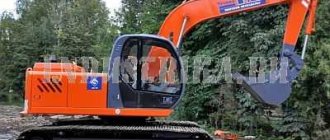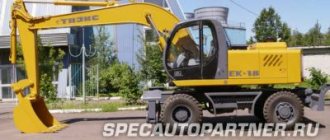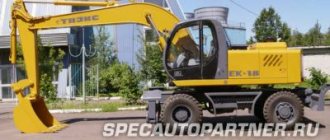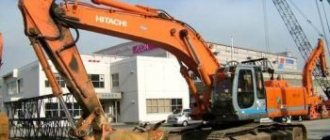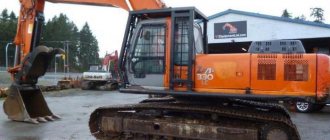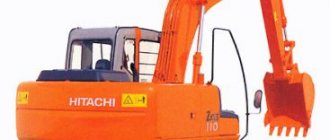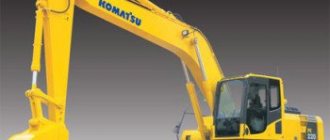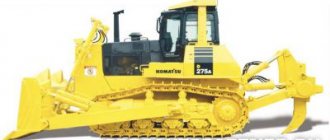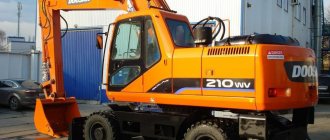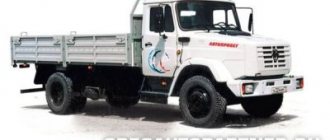For questions regarding the purchase of this equipment (TVEX ET-14 crawler excavator), terms of credit and leasing, service and warranty, please contact the plant’s dealers or official representative offices. The TVEX ET-14 crawler excavator can be supplied either directly from the manufacturer or from sites in Moscow and other regions of the Russian Federation.
Technical characteristics of the TVEX ET-14 excavator
| Weight, t | 14,8 |
| Bucket capacity (according to SAE), m3 | 0,65 (0,5; 0,4; 0,32) |
| Length, mm | 8200 |
| Width, mm | 2750 |
| Height, mm | 2990 |
| Engine | Perkins 1104C-44TA |
| Engine power, hp | 123 |
| Cycle duration, s | 16 |
| Pressure in the hydraulic system, MPa | 28 |
| Specific ground pressure, kg/cm2 | 0,39 |
| Travel speed, km/h | 2,4 |
Spare parts and repairs EO-3323
No matter how reliable an excavator is, there may come a time when it may need professional help. An experienced team of specialists with extensive experience in the Tvermashkomplekt company is ready to carry out the necessary repairs and maintenance of EO-3323 brand excavators in the shortest possible time.
We have direct deliveries from the manufacturer, so we can repair excavators or sell spare parts at minimal prices. If you no longer need the excavator, we are ready to buy it back at a good price.
Important Motoblocks: purpose and features of choice
Source
Digging parameters of the TVEX ET 14 excavator
| Handle, m | 1,9 | 2,2 | 2,8 | 3,4 |
| Digging radius, m | 8,2 | 8,4 | 9,0 | 9,6 |
| Digging radius at parking level, m | 8 | 8,28 | 8,86 | 9,49 |
| Kinematic digging depth, m | 5,2 | 5,5 | 6,1 | 6,7 |
| Unloading height, m | 5,42 | 5,57 | 5,88 | 6,18 |
| Bucket rotation angle (deg.) | 173 | 173 | 173 | 173 |
| Maximum bucket capacity (according to SAE), m3 | 0,65 | 0,5 | 0,4 | 0,32 |
| 1 | handle 1.9 m |
| 2 | handle 2.2 m |
| 3 | handle 2.8 m |
| 4 | handle 3.4 m |
Advantages of the EO-4225A crawler excavator
The design of the base chassis has a low impact on the ground and does not exceed 0.55 kg/ms.
kV, with a minimum track width of 600 mm, which allows the unit to be used on complex and viscous soils. This is also facilitated by the increased ground clearance of 1100 mm. The maximum obstacle overcoming angle is 35º. The operation of the actuators is ensured by a hydraulic system using a reinforced hydraulic hose and driven by a power plant. Maximum traction force 21 tf.
The maximum unloading height is 5.15 m, which is quite enough for loading operations using most models of automotive equipment or railway cars.
The maximum radius of excavation work is 9.3 m.
The operator's cabin is located on the same platform as the equipment. The large glass area provides an excellent overview of the production site. The workplace is equipped with a comfortable chair with the ability to adjust the position and an air conditioner for comfortable work.
Recommendations
Work in off-road conditions on construction sites. Working in cramped conditions.
The short track allows the excavator to be transported on a standard trailer, with the track mounted perpendicular to the trailer. The reduced radius of the turntable allows you to work in cramped conditions.
The excavator can be equipped with various types of replaceable working equipment and working parts:
- Interchangeable handle lengths: 2200 mm, 2800 mm, 3400 mm
- Buckets with the following capacities: 0.65 m3, 0.5 m3, 0.4 m3, 0.32 m3
- Hydraulic hammer MG-300
- Grab GK-221
- Ripper 314-03-40.17.300
The engines fully comply with all international environmental requirements and have a number of significant advantages:
- twice the service life and warranty period compared to domestic engines;
- 10% more torque;
- ensuring fuel savings of 10-20% depending on the type of work;
- reduction of maintenance time by 20% due to increased intervals between maintenance;
- reduction of noise and vibration at the operator’s workplace.
Materials used by Tverskoy Excavator OJSC, https://www.tvexc.ru.
Single-bucket excavator ET-14 [DOC] – Everything for the student
Technical description and operating instructions.
214-20-00.00.000 TO Tver: JSC “Tver Excavator”, 2006. – 86 p. Contents Introduction Brief technical characteristics Purpose Technical characteristics Operation of the excavator Excavator controls Instructions for safety measures Safety measures when working on an excavator Safety measures for maintenance and routine repairs excavator Actions in extreme situations Preparation for work. Run-in Acceptance Procedure for installing parts and assemblies removed for transportation onto the excavator Run-in General notes Preparation for break-in Run-in at idle Run-in under load Maintenance after run-in Operating procedure Operations performed before starting work Starting the engine Putting the excavator into operation in cold weather years Preparation for winter operation Starting the engine Operations performed after starting the engine Stopping work Digging Safe operation parameters Replacing working equipment Transportation of the excavator Moving the excavator under its own power Transportation by rail Preservation and storage of the excavator Preservation of the excavator Storage of the excavator Preparing the excavator for operation after storage Maintenance Basic adjustments characteristics List of works performed during periodic maintenance Maintenance of individual systems and mechanisms of the excavator Maintenance of the hydraulic system Rules for disassembling the hydraulic system Instructions for the use of working fluid The procedure for replacing the working fluid Setting safety valves General instructions The procedure for setting safety valves Charging the pneumatic accumulator cylinder Adjusting the lowering speed of working bodies Maintenance of the roller slewing bearing device Adjustment of the track tension mechanism Lubrication instructions List of working fluids, oils, lubricants, fuels used in the operation of the excavator Table of oil substitutes Product composition Design and operation of the components of the excavator Crawler track Running frame Track roller Travel drive Slewing support device Idler wheel with a mechanism for tensioning the caterpillar track Track device Devices mounted on the turntable Rotating mechanism Cabin and hood Installation of engine preheating and cabin heating Design and principle of operation Rules for operating the heater Safety measures when operating the heater Working equipment Hydraulic system Hydraulic equipment Pumping unit Hydraulic distributor GR Valve block Hydraulic cylinders Central manifold Pneumo-hydraulic accumulator Control units Oil cooling unit Hydraulic tank and filters Electrical equipment Excavator supply Applications Soil classification Possible malfunctions and methods for their elimination Places for installing seals on the excavator during the warranty period www.twirpx.com
Modifications
There are several modifications of the equipment; the main distinguishing features of each model are the hydraulic system and motor. The latter can be installed foreign or Russian-made. The foreign unit is characterized by higher power, efficiency and long periods between maintenance.
| Model | EK-18-20 | EK-18-30 | EK-18-60 | EK-18-90 |
| Engine | MMZ 245S | Perkins 1104C-44TA | D-245 2S2 | |
| engine's type | Diesel, liquid cooling | |||
| Engine power, hp | 105 | 123 | 122 | |
| Hydraulics | PSM | Bosch-Rexroth | ||
| Handle, m | 2,2/,2,8/3,4 | |||
| Bucket capacity, cubic meters m | 1,0/0,7/0,65 | |||
| Digging depth | 5,77/6,37/6,97 | |||
| Unloading height, m | 6,24/6,5/6,75 | |||
| Cycle duration, s | 18,5 | |||
| Travel speed, km/h | 20 | |||
| Overall dimensions, mm | 9360/2500/3158 | |||
| Equipment weight, t | 18,4 |
EK-18 modifications:
- standard model EK-18;
- TVEX EK-18-20 is characterized by increased efficiency; a standard working element (bucket) with a capacity of 1 cubic meter is installed on it. m. All equipment components are produced in Russia. The main frame has a reinforced structure, which guarantees high performance when working in harsh conditions. TVEX 18-20 can be equipped with a large number of additional working parts. This modification is considered the most powerful and multifunctional;
- EK-18-30 is the previous model with an improved foreign-made hydraulic system;
- The EK-18-40 has a clamshell grab as a working tool as standard. This special equipment is most often used in logging and scrap metal processing plants. Optionally, this model can be equipped with a lifting cabin (using hydraulics) and a scrap body;
- EK-18-44 is an improved version of the previous model. A hydraulic lifting cabin, a scrap organ, a five-jaw grab with a capacity of 0.65 m3, and a full-rotary rotator are standardly installed here. Its main purpose is loading and unloading of gondola cars, as well as work for which the EK-18-40 modification is intended;
- TVEX EK-18-60 is equipped with a hydraulic propulsion motor jointly produced by Bosch and Rexroth, a hydraulic pump, and a power unit manufactured by Perkins;
- EK-18-90M is the latest development of the manufacturer, in which axles with limited slip differentials are installed, which improves the ability to overcome difficult areas. The steering wheel made in Italy is smaller in size, which creates more comfortable working conditions for the operator. In addition, the cabin has increased rigidity. The power plant is characterized by increased power indicators, which has a beneficial effect on the efficiency of the equipment. Optionally, handles of various sizes are installed; 2.2 m is used as standard. Increasing its length promotes deeper digging, but the capacity of the working body is reduced.
Important Partner motor cultivators for tillage
Specifications
Technical characteristics of EO 4225EO are designed with a safety margin for heavy excavation work. A detailed description of the model is presented in the instruction manual that comes with each machine. If lost, you can easily find it or download it from the Internet.
Main parameters:
- Weight - 26450 kg.
- Bucket volume - 0.6-1.42 cubic meters.
- Travel speed 4.2 km/h.
- Traction force - 210 kN.
- Travel speed - 4.2 km/h.
- Platform rotation speed - 9.1 rpm.
- The maximum climbable grade is 35°.
The EO 4225 excavator has several modifications
. Dimensions:
- length - 10250 mm;
- width (along the turntable) - 3000 mm;
- height - 3000 mm (transport - 3300 mm).
Digging radius - 10.3 m. Digging depth - 7.3 m. Digging height - 7 m. Unloading height - 5.4 m.
Engine
All excavators of the Kovrov plant were equipped with a YaMZ-238 GM2 engine with direct fuel injection without turbocharging. This is a reliable motor from the Yaroslavl Motor Plant, installed on a wide range of special equipment. Equipped with a pre-heater to facilitate starting at low temperatures.
Engine - YaMZ-238 GM2:
- volume - 14.86 l;
- power - 170 hp / 125 kW;
- fuel - diesel;
- number of cylinders - 8;
- cylinder arrangement - V-shaped;
- type - 4-stroke;
- cooling - liquid;
- fuel consumption - from 220 g/kWh / 162 g/l.h.
Chassis
The design is based on a tracked carriage on several supporting elements, supplemented by a track tensioning mechanism. This is a simple and reliable system with a long service life and minimal risk of breakdowns. The tension mechanism units are reliably sealed with high quality seals. This made it possible to achieve maximum stability and softness of the machine.
The running system of the E0-4225 excavator is a ten-roller balancing system. The crawler track provides stability on soft soils and excellent cross-country ability. The platform is equipped with a planetary rotation mechanism. Planetary gearboxes have increased reliability and provide trouble-free operation for many years.
Steering
The excavator is controlled from the cab using levers or joysticks. The controls allow you to effectively control the speed and trajectory of the machine, connect various attachments and perform precise manipulations.
Hydraulic system
The hydraulic system drives all the main working elements of the machine. It is powered by a diesel engine. The system is equipped with an automatic switch-on function and is capable of pumping up to 400 l/min. The working pressure in the hydraulic system is 28 MPa, the hydraulic fluid flow rate is about 2x200 l/min. The condition of both the hydraulic system and the engine is monitored using a microprocessor system.
Operator's cabin
The excavator is equipped with a new, convenient lifting cabin of improved design. The operator's workplace has become significantly more comfortable compared to previous models. This was facilitated by a number of improvements. Firstly, the glazing area was increased. This provided the operator with an excellent overview of the work area. Secondly, the controls (levers, joysticks, pedals) are located ergonomically, making it as easy as possible to operate the machine. Thirdly, control of equipment systems is easier - for this purpose, there is an electronic control panel in the cabin. In addition, the cabin has a comfortable adjustable seat, an efficient heating system and optional air conditioning.
TVEX ET-25
Let's consider the TVEX ET-25 model: main characteristics and description of the mechanism. Tver excavators of the ET-25 model are machines of the fourth size group, which are suitable for use over large areas and for performing large volumes of work. A similar technique is used to loosen soil, including frozen soil, and to crush rocks.
Other areas in which TVEX ET-25 can be used include:
- development of pits and pits;
- development of quarries and trenches;
- soil loading;
- reclamation works.
The machine moves on caterpillar tracks, which allows the equipment to work on any soil.
The advantages of this model include factors such as:
- Stability and high performance.
- Long service life.
- Reliability.
- Easy to operate and maintain.
- Multifunctionality.
- Convenient control panel.
- A single cabin with a comfortable seat and compartments for storing personal belongings.
It is produced in three modifications - the TVEX ET-25-20, 25-30, 25-40 excavator.
See » Kubota K008 mini crawler excavator
The mechanism is equipped with a Perkins 1104C-44TA engine, the power of which is 175 hp, the number of revolutions is 1.7 thousand rpm.
Excavator grab
Construction machines and equipment, reference book
Category:
Excavator operation
The grab is used for developing soils located below and above the excavator parking level, for loading and unloading bulk materials, as well as for some types of excavation work in soft soils (digging deep pits, cleaning ponds and canals).
The grab works as follows. When the closing rope is loosened, the grab is held by a support rope attached to the upper head of the grab. The lower head, under the influence of its own weight, lowers along with the lower blocks of the closing rope pulley mounted on it and the hinged jaws.
Rice. 25. Suspension of an oblique dragline bucket: 1 — bucket body, 2 — bucket visor, 3 — traction chain loops, 4 — traction chain eyes, 5 — tipping rope, 6 — tipping rope block cage, 7 — lifting rope, 3 — lifting chains , 9 — rings, 10 — tilting pipes
Cassock. 26. Diagram of a grab suspended on an excavator: 1 - grab. 2— outhaul rope, 3— boom, 4— outhaul rope blocks, 5— outhaul weight. 6 - closing rope, 7 - supporting rope, 8 - closing rope drum, 9 - supporting rope drum, 10 - upper head, 11 - rods, 12 - lower blocks of the closing rope pulley, 13 - lower head, 14 - jaws; I—IV — grab positions
When the lower head is lowered, the jaws open, turning relative to rigid rods, hinged at the lower ends on the jaws, and at the upper ends on the upper head (position I). In this position, the bucket is lowered onto the ground or other material being grabbed so quickly that the teeth of the jaws cut into the material. Then the supporting rope is loosened and the closing rope is wound onto the drum. At the same time, the lower and upper heads of the grab are pulled together, and the jaws close, crashing into the ground and grabbing it (position II).
After closing the jaws, the grapple filled with soil is lifted on the closing rope. At the same time, the drum is set in motion to select the support rope at the same speed (position III). When the platform with the boom is turned to the unloading site, the supporting rope drum is braked, and the closing rope 6 is weakened, which leads to the lowering of the lower head with the jaws and to the unloading of the grab (position IV).
Unloading can be done at any height using the indicated method or by braking the drum while further winding the supporting rope onto the drum.
After unloading, the grab is turned back to the mining site and the cycle is repeated.
To prevent twisting of the ropes and significant swinging of the grab when turning the platform, a pull-out device called a damper is used. It acts on the grab bucket with a pull rope. The constant tension of the rope 2, independent of the position of the grab, is created by the weight of the load moving inside the boom along the guides, to which the rope bending around the blocks is attached.
On some excavator cranes, for this purpose they use the mechanism described below for opening the bottom of the bucket, on the drum of which a rope is attached.
The grab is equipped with a dragline lattice boom.
In addition to the two-jaw grab, there are grabs with a large number of jaws; the number and shape of the jaws depend on the type of material being handled. However, the principle diagram of their operation does not differ from the diagram of a double-jaw grab.
The disadvantage of a grab suspended on ropes is that it is impossible for them to develop dense soils: the weight of the grab is not enough to crash into the ground. Grabs are made of three types: light, medium and heavy, and the weight of the grapple used should be greater, the denser the soil. However, the heavier the grab, the less soil it can lift for a given excavator-crane stability. Consequently, the productivity of the equipment decreases.
Some foreign companies produce rigidly suspended grabs, which are mounted on the handle of a backhoe instead of a bucket. The jaws of such a grab are closed by hydraulic cylinders driven by fluid supplied from the pump. The main advantage of a rigidly suspended grab is that it can create the necessary pressure on the ground when cutting in, that is, regardless of the weight of the grab, it can successfully develop dense soils.
Read more: Crane equipment for excavators
Category: — Operation of excavators
Purpose
The EK 14 multifunctional excavator is a pneumatic-wheeled mobile earth-moving device designed for the preparation of trenches, pits, and quarries when processing soils of various hardness categories (from 1 to 4): loose, loose, plant layers, including frozen rocks. For this purpose, it is equipped with a powerful hydraulic system that drives a movable metal boom structure with a handle and a bucket with a capacity of up to 0.8 m³. The equipment is able to cope with large crushed stone, gravel, as well as stones with a diameter of up to 20 cm, has great power, and the ability to function without interruption for a long period of time. The movement of the working body, excavation, and rotation of the platform occurs with a stationary chassis, which expands the capabilities of the equipment.
This is interesting: Multi-bucket bucket wheel excavators
Features and Benefits
The excavator is often used in peat mining enterprises. This is due to the installation of wider tracks, which reduces the load on the base. Areas of application include construction, where the machine easily handles soils of all categories.
Careful study of all design components made it possible to create equipment capable of operating in difficult conditions. Bad weather and unstable soil are not an obstacle to completing the tasks. The control system allows operators without experience to operate the EO-3223 excavator, because it is understandable on an intuitive level.
To increase productivity and implement territory planning, a “floating” boom design is provided. When cleaning channels, maximum efficiency is achieved when activating the “micro movement” mode, in which the movement speed is 200 m/h. The main part of the power in this case is transferred to the attachments.
The advantages of the 3223 single-bucket excavator are:
- ease of management and maintenance;
- stability on any type of base;
- precision control of working parts;
- durability;
- multifunctionality due to the installation of various working bodies;
- low cost of components;
- high quality;
- permeability.
